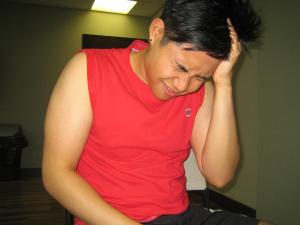A migraine headache causes concentrated throbbing or a pulsing sensation felt in one region of the head along with nausea, vomiting as well as sensitivity to certain sounds and lights. Migraine attacks can last for hours up to days and it can be severe. Some cases of migraine are accompanied by sensory warning symptoms also known as an aura such as flashes of light, tingling in the arms and legs and a blind spot.
A migraine headache begins during childhood, adolescence and early adulthood, and there are four stages of migraine namely prodrome, aura, headache and postdrome. Some people cannot experience these four stages of migraine.

An aura can occur before or during migraine attacks and there are nervous system symptoms such as visual disturbances like flashes of light. Sometimes, the auras are touching sensations or sensory, movement or speech as well as verbal disturbances. The symptoms begin gradually and become severe for several minutes and last for 20 to 60 minutes.
An untreated migraine can last from 4-72 hours but the frequency varies from person to person. During a migraine attack, an individual can experience the following symptoms:
- Pain that is pulsating and throbbing
- Pain on one side or both sides of the head
- Blurry vision
- Sensitivity to sounds, light and even certain smells
- Individual experiences nausea, vomiting, light-headedness and sometimes fainting
Causes
- Hormonal changes in women such as the rise and fall in estrogen will cause headaches. Some women suffer migraine attacks before or during their monthly periods but some women can suffer from migraines during pregnancy and menopause.
- Some hormonal medications such as oral contraceptives and hormone replacement therapy can worsen migraines in women.
- Salty foods, aged cheese and processed foods can also cause migraines.
- Skipping or fasting from meals can cause migraines
- Food additives like sweeteners and monosodium glutamate found in foods can also cause migraines
- Drinking wine and alcohol
- Stress from home and work
- Bright lights and glares of sun, unusual smell such as perfumes, paint thinner, second hand smoke as well as exposure to loud sounds
- Changes in the weather conditions
Treatment and home remedies
- Perform exercises for muscle relaxation such as meditation and yoga to help minimize pain caused by migraines.
- Get enough sleep every night.
- Apply an ice compress on the forehead and place both feet in warm water. You can learn more about this treatment by enrolling in a first aid course.
- Encourage the individual to drink juices that contain vitamin C especially tomato juice which can help get rid of migraines.
- Gently massage the head, face and neck. Apply gentle pressure at the back of the neck at 2 minutes at a time and slowly release and repeat the procedure.
- Avoid getting stressed at home or work.
- Perform aerobic exercises in order to reduce tensions to minimize migraine attacks.
